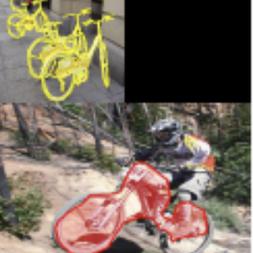Semantic Segmentation
5199 papers with code • 125 benchmarks • 311 datasets
Semantic Segmentation is a computer vision task in which the goal is to categorize each pixel in an image into a class or object. The goal is to produce a dense pixel-wise segmentation map of an image, where each pixel is assigned to a specific class or object. Some example benchmarks for this task are Cityscapes, PASCAL VOC and ADE20K. Models are usually evaluated with the Mean Intersection-Over-Union (Mean IoU) and Pixel Accuracy metrics.
( Image credit: CSAILVision )
Libraries
Use these libraries to find Semantic Segmentation models and implementationsSubtasks
-
 Tumor Segmentation
Tumor Segmentation
-
 Panoptic Segmentation
Panoptic Segmentation
-
 3D Semantic Segmentation
3D Semantic Segmentation
-
 Weakly-Supervised Semantic Segmentation
Weakly-Supervised Semantic Segmentation
-
 Weakly-Supervised Semantic Segmentation
Weakly-Supervised Semantic Segmentation
-
 Scene Segmentation
Scene Segmentation
-
 Semi-Supervised Semantic Segmentation
Semi-Supervised Semantic Segmentation
-
 Real-Time Semantic Segmentation
Real-Time Semantic Segmentation
-
 3D Part Segmentation
3D Part Segmentation
-
 Unsupervised Semantic Segmentation
Unsupervised Semantic Segmentation
-
 Road Segmentation
Road Segmentation
-
 One-Shot Segmentation
One-Shot Segmentation
-
 Bird's-Eye View Semantic Segmentation
Bird's-Eye View Semantic Segmentation
-
 Crack Segmentation
Crack Segmentation
-
 UNET Segmentation
UNET Segmentation
-
 Universal Segmentation
Universal Segmentation
-
 Class-Incremental Semantic Segmentation
Class-Incremental Semantic Segmentation
-
 Polyp Segmentation
Polyp Segmentation
-
 Vision-Language Segmentation
Vision-Language Segmentation
-
 4D Spatio Temporal Semantic Segmentation
4D Spatio Temporal Semantic Segmentation
-
 Histopathological Segmentation
Histopathological Segmentation
-
 Attentive segmentation networks
Attentive segmentation networks
-
 Text-Line Extraction
Text-Line Extraction
-
 Aerial Video Semantic Segmentation
Aerial Video Semantic Segmentation
-
 Amodal Panoptic Segmentation
Amodal Panoptic Segmentation
-
 Robust BEV Map Segmentation
Robust BEV Map Segmentation
Latest papers with no code
Efficient Transformer Encoders for Mask2Former-style models
The third step is to use the aforementioned derived dataset to train a gating network that predicts the number of encoder layers to be used, conditioned on the input image.
Ultrasound SAM Adapter: Adapting SAM for Breast Lesion Segmentation in Ultrasound Images
To address these issues, in this paper, we develop a novel Breast Ultrasound SAM Adapter, termed Breast Ultrasound Segment Anything Model (BUSSAM), which migrates the SAM to the field of breast ultrasound image segmentation by using the adapter technique.
CFPFormer: Feature-pyramid like Transformer Decoder for Segmentation and Detection
Feature pyramids have been widely adopted in convolutional neural networks (CNNs) and transformers for tasks like medical image segmentation and object detection.
OccFeat: Self-supervised Occupancy Feature Prediction for Pretraining BEV Segmentation Networks
Models pretrained with our method exhibit improved BEV semantic segmentation performance, particularly in low-data scenarios.
360VOTS: Visual Object Tracking and Segmentation in Omnidirectional Videos
Visual object tracking and segmentation in omnidirectional videos are challenging due to the wide field-of-view and large spherical distortion brought by 360{\deg} images.
PM-VIS: High-Performance Box-Supervised Video Instance Segmentation
Our PM-VIS model, trained with high-quality pseudo mask annotations, demonstrates strong ability in instance mask prediction, achieving state-of-the-art performance on the YouTube-VIS 2019, YouTube-VIS 2021, and OVIS validation sets, notably narrowing the gap between box-supervised and fully supervised VIS methods.
PV-S3: Advancing Automatic Photovoltaic Defect Detection using Semi-Supervised Semantic Segmentation of Electroluminescence Images
Traditional manual health check, using Electroluminescence (EL) imaging, is expensive and logistically challenging making automated defect detection essential.
PEMMA: Parameter-Efficient Multi-Modal Adaptation for Medical Image Segmentation
In this work, we propose a parameter-efficient multi-modal adaptation (PEMMA) framework for lightweight upgrading of a transformer-based segmentation model trained only on CT scans to also incorporate PET scans.
Semantic-Rearrangement-Based Multi-Level Alignment for Domain Generalized Segmentation
SRMA first incorporates a Semantic Rearrangement Module (SRM), which conducts semantic region randomization to enhance the diversity of the source domain sufficiently.
A Complete System for Automated 3D Semantic-Geometric Mapping of Corrosion in Industrial Environments
Corrosion, a naturally occurring process leading to the deterioration of metallic materials, demands diligent detection for quality control and the preservation of metal-based objects, especially within industrial contexts.






























































































































 MS COCO
MS COCO
 Cityscapes
Cityscapes
 KITTI
KITTI
 ShapeNet
ShapeNet
 ScanNet
ScanNet
 ADE20K
ADE20K
 NYUv2
NYUv2
 DAVIS
DAVIS
 SYNTHIA
SYNTHIA
 EuroSAT
EuroSAT